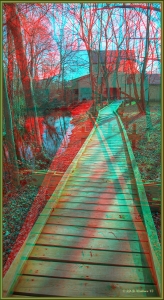Looking for design inspiration? Browse our curated collections!
10 Years Ago

Where you can find 3D glasses for the purpose of viewing 3D Stereo Anaglyph images...
Anyone interested in obtaining 3-D glasses from one of the vendors below should contact the vendor directly to check on availability and prices. When using 3-D glasses, remember that the left eye should be red, and the right eye blue.
United States
Deep Vision 3D
P.O. Box 38386
Hollywood, CA 90038 USA
(323) 465-5819
AnaChrome 3D
PO Box 941112
Simi Valley, CA 93094-1112 USA
(818) 399-9745
Rainbow Symphony, Inc.
6860 Canby Ave. Suite 120
Reseda, CA 91335 USA
(818) 708-8400
3Dstereo.com, Inc
930 Village Center Circle, #3-333
Las Vegas, NV 89134 USA
Tel: (702) 838-7015
Fax: (702) 838-7016
DIMENSION 3
256 S. Robertson Blvd.
Beverly Hills, CA 90211 USA
(818) 592-0999
Berezin Stereo Photography Products
21686 Abedul Mission Viejo, CA 92691 USA
(949) 215-1554
American Paper Optics LLC
3080 Bartlett Corporate Drive
Bartlett, Tennessee 38133 USA
(901) 381-1515 --- (800) 767-8427
Fax: (901) 381-1517
Ray 3D Zone
PO Box 741159
Los Angeles, CA 90004 USA
Europe
Relief virtuel Stereoscopy
16 Route de la Briqueterie
44380 Pornichet France
Tel. : 33 (0) 2 40 11 62 99
Fax : 33 (0) 2 40 61 16 92
AstroMedia
Katernberger Straße 107 45327
Essen Germany
Tel. ++49 (0) 201 - 6 34 97 60
Fax ++49 (0) 201 - 6 34 97 66
Pixel
P.O. Box 1450
3000 BL, Rotterdam The Netherlands
Tel.: +31 10 2449050
Reply Order
10 Years Ago
you could probably make your own too with color transparent cellophane and cardstock.
Just a thought. :)
10 Years Ago
Yes Richard, you CAN make your own, but when I tried it, I was a little disappointed in the result. There are even websites that have guides for you to print out. I had to make trips to the crafts store etc. The cardboard variety are cheap if you order them and you can purchase a package. Actually the cardboard variety seem to have the best lenses.
10 Years Ago
Can't beat the prices.. AND free shipping.
I have used this site many times and have not had any issues. Shipping is quick.. and did I mention.. FREE shipping ;O)
http://www.tmart.com/3D-Video-Glasses/
10 Years Ago
2D Flat Image...
* * * * * * * * * * * * * * * * * * * * * * * * * * * * * * * * * * * * * * * * * * * * * * * * * * * * * * * * * * * * * * * * * * * * * * * * * *
Below: 3D Stereo Anaglyph - Red/Cyan filtered 3D glasses required for viewing.
http://fineartamerica.com/showmessages.php?messageid=1766455 ...
Both images were captured using the same single camera. For the 3D stereo anaglyph version I made two captures from slightly different horizontal perspectives. The technique is called a "cha cha", named for shifting your weight from one side to the other for the second shot. During processing, I combine the two images together and align them. There is freeware that can align the stereo pair automatically or you can process it manually.
10 Years Ago
A good basic technique to keep in mind when producing 3D stereo images is to have several (at least 3) levels of depth. Generally you also try to keep away from a large area where there are no elements to represent depth such as a vast sky, water, or ground with nothing in it. These are some of the general rules which when understood, can be used as guidelines and bent or sometimes broken when needed. There are often trade-offs of one kind or another when considering the entire composition relating to the image format in general.
10 Years Ago
My FAA 3D Stereo Anaglyph Gallery...
http://fineartamerica.com/profiles/brian-wallace.html?tab=artworkgalleries&artworkgalleryid=73725
10 Years Ago
What a coincidence. My son was asking me about printing 3d images. Is there a special printer needed?
10 Years Ago
Craig, I have printed them with a normal printer but I prefer just viewing them on a monitor.
I have a small 3D camera about the size of a P&S (Fujifilm Real 3D W1 and W3), which lets you view the 3D stereo image without the use of 3D glasses. I carry it around in my pocket. It also takes 2D or 2D and 3D simultaneously as well as 3D video. There are other similar 3D camera brands available today. They also make larger digital monitors that allow glassless viewing but they are much more expensive. I can also view my 3D images on a 3D capable TV of which there are several types. Mine requires Shutter Glasses, which are bulky but there is no ghosting since the glasses alternate your view between the left and right eye but it switches too fast for the brain to notice. There's also a type of monitor and 3D TV that allows you to view using polarized glasses (like today's movie theaters generally use).
FAA's printing contractor have printed a couple of my anaglyphs because they were purchased. I've had no returns on them.
10 Years Ago
3D Stereos that sold on Fine Art America...
3D Stereo Anaglyphs...
http://brian-wallace.artistwebsites.com/saleannouncement.html?id=92ba018bf195e62a439d140989519c22
http://brian-wallace.artistwebsites.com/saleannouncement.html?id=c7c6d6ba2f910840766863b4bbfd9d88
http://brian-wallace.artistwebsites.com/saleannouncement.html?id=bfa72521c80cac49f9d67333e1d6fbfd
3D Stereo Crossviews...
http://brian-wallace.artistwebsites.com/featured/massive-dragon--gently-cross-your-eyes-and-focus-on-the-middle-image-brian-wallace.html
http://brian-wallace.artistwebsites.com/saleannouncement.html?id=f69a88541da828c289beee1147150acc
9 Years Ago
Here is an example of a 3D anaglyph composite (several images combined together), with a portion of the image depth achieved by shifting pixels through the process of cloning (2D to 3D conversion)...
"Thinking Inside The Box" is a 3D stereo anaglyph which requires Red/Cyan filtered 3D glasses for viewing...
9 Years Ago
{gift.baby27@yahoo.com}
Hello, my name is Gift,when i was searching for a good friend as i come across your profile my mind tell me to stop that i have see a good friend and i believed that both of us will be a good friend and share with each other by the special grace of God you can connect me through my private in box{gift.baby27@yahoo.com}...{fineartamerica.com}
9 Years Ago
Just crossing the 6 thousand views mark in 3 months for this thread. I've been saying all along there is a 3D community out there! Thanks for proving it to FAA. Now, if we can get FAA to offer 3D glasses as well, they could be a one-stop shop for the 3D market and more 3D anaglyph art will become available from here.
Here is a link to the FAA group, "Anaglyph Art" for you to check out...
http://fineartamerica.com/groups/anaglyph-art.html
9 Years Ago
Very interesting work Brian, Thanks for sharing. I'm not a photo person but reading about all the things you and others do on FAA is amazing. Keep up the great work.
9 Years Ago
Thanks for your response Kim. I'm pleased especially if a non-photographer finds this type of work interesting. :)
9 Years Ago
3D Stereo Anaglyph fantasy image of unknown lights in the sky, typically thought of as UFOs. The sky and landscape is a real photograph with the lights added digitally for effect. The image was then converted from 2D to 3D through the method of shifting pixels so that depth will be visible with the use of Red/Cyan filtered 3D glasses. Glasses are inexpensive and can be obtained online. I recommend "Rainbow Symphony", or "American Paper Optics".
9 Years Ago
Happy New Year Everyone!!!
Flickr Link to OOF (Out Of Frame) 3D stereo images... https://www.flickr.com/photos/ur4chun8/sets/72157626142999873/
(You will find both Anaglyph and Crossview formats done in the OOF style)
9 Years Ago
Some information for the 3D Stereo Enthusiasts who convert 2D to 3D or otherwise create 3D images...
3D stereo has been around almost as long as photography. There is a freeware out that the majority of 3D stereo enthusiasts have been using for the last 8 yrs or so. Unlike some other freeware used for aligning and creating 3D images, this one has been regularly updated and upgraded which has kept it in sync with new file formats and other newer technologies.
A few years ago this freeware called "StereoPhoto Maker" updated it's software to include a clone tool. This tool was meant for small fixes such as mis-sync in alignment of an object due to movement or difference in light balance between the stereo pair, and even differences in color and shades of the Left and Right "chip" or images that make up the stereo pair.
As soon as the clone tool was added I realized that although it was not designed for cloning an entire image, it could still be used for that purpose. Many people have a desire to convert a 2D image into 3D and there have been several techniques for accomplishing this feat. I was the first however to use the clone tool of SPM to shift pixels and convert an entire 2D image to 3D from within the software. I wrote a tutorial on the process and have shared it with 3D stereo groups I'm associated with.
The example below takes an image from start to finish in the combination of several methods and techniques used to convert a 2D image into several 3D formats with some bonus effects, namely OOF (Out Of Frame) also known as OOB (Out Of Bounds) which by itself has been used primarily for only 2D images such as ads and magazine covers because it's purpose is to effect a pseudo 3D quality which garnishes more attention than a regular flat 2D image. Using the OOF (pseudo 3D effect on an actual 3D stereo instead of 2D however provides certain benefits to the person creating a 3D stereo. One of the prime advantages is the ability to reduce the deviation (space between left and right chips (images of a subject captured from slightly different angles that make up the stereo pair). This deviation is related also to the "Stereo Base" used that provides the depth perception when viewing the stereo image. If the deviation is too great it causes problems viewing as well as increases the chance of harsh ghosting in 3D anaglyphs (the kind of stereo that requires Red/Cyan filtered 3D glasses).
All 3D stereo formats have their own set of advantages and disadvantages and a good stereographic artist uses different means to overcome or reduce these sometimes inherent roadblocks. Indeed, as you might have guessed, creating 3D stereos are very challenging if done well.


